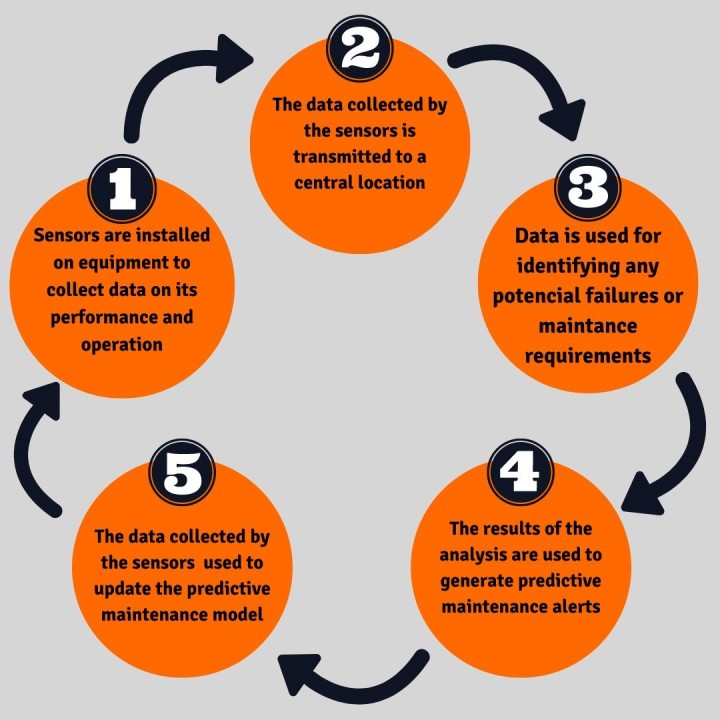What is Predictive Maintenance (PM) and Why is it Important?


Suleiman Waiguru
February 4th 2023
Predictive maintenance is a type of maintenance strategy that uses artificial intelligence (AI) and other technologies to predict when equipment is likely to fail or require maintenance, based on data collected from sensors and other sources. By identifying potential issues before they occur, companies can schedule maintenance in advance and reduce downtime, which can help to improve productivity and save money.
There are several ways that predictive maintenance can be implemented in computing services:
- Machine learning algorithms can be used to analyze data from sensors and other sources to identify patterns that may indicate a potential failure. This can include data on the performance and operation of the equipment, as well as environmental conditions.
- Remote monitoring systems can be used to collect data from equipment and transmit it to a central location for analysis. This can allow maintenance teams to monitor equipment remotely and identify potential issues before they occur.
- Predictive maintenance systems can be integrated with other systems, such as enterprise resource planning (ERP) systems, to help companies schedule maintenance and track the status of equipment.
- Predictive maintenance can be combined with other types of maintenance strategies, such as condition-based maintenance, to provide a more comprehensive approach to equipment management.
How does PM Work Exactly?
In predictive maintenance, data from sensors and other sources is used to predict when equipment is likely to fail or require maintenance. Here is a general outline of the process:
- Sensors are installed on equipment to collect data on its performance and operation. This can include data on temperature, vibration, pressure, and other factors that may indicate a potential issue.
- The data collected by the sensors is transmitted to a central location, such as a cloud-based platform, for analysis.
- Machine learning algorithms are used to analyze the data and identify patterns that may indicate a potential failure or maintenance requirement.
- The results of the analysis are used to generate predictive maintenance alerts, which are sent to maintenance teams to schedule maintenance as needed.
- The data collected by the sensors is also used to update the predictive maintenance model, helping it to become more accurate over time.
Overall, the process of using data from sensors and other sources in predictive maintenance involves collecting data on the performance and operation of equipment, analyzing the data to identify potential issues, and using the results to schedule maintenance as needed.
What are the Benefits of PM?
Predictive maintenance is a type of maintenance strategy that uses artificial intelligence (AI) and other technologies to predict when equipment is likely to fail or require maintenance, based on data collected from sensors and other sources. There are several benefits to using predictive maintenance including:
- Reducing downtime: by identifying potential issues before they occur, companies can schedule maintenance in advance and reduce the risk of unexpected failures, which can help to improve productivity and reduce downtime.
- Improving productivity: by avoiding unexpected failures, companies can avoid the disruptions and lost time that can result from unexpected downtime, which can help to improve overall productivity.
- Saving money: by reducing the need for unplanned maintenance and downtime, companies can save money on maintenance costs and lost productivity.
- Extending equipment life: by performing maintenance only when it is needed, rather than on a predetermined schedule, companies can extend the life of their equipment and delay the need for expensive replacements.
- Improving equipment reliability: by ensuring that equipment is in good condition at all times, companies can improve its reliability and performance, which can help to reduce the risk of failures and improve customer satisfaction.
Interesting Examples of PM in Use
Here are some interesting examples of predictive maintenance:
- In the aviation industry: it is used to identify potential issues with aircraft engines and other components before they occur. For example, data from sensors can be used to predict when an engine is likely to require maintenance or when a component is likely to fail. This can help to reduce downtime and improve safety.
- In the transportation industry: it is used to identify potential issues with vehicles, such as buses, trains, and trucks. Data from sensors can be used to predict when a vehicle is likely to require maintenance or when a component is likely to fail, helping to reduce downtime and improve reliability.
- In the manufacturing industry: it is used to identify potential issues with equipment, such as machine tools and production lines. Data from sensors can be used to predict when equipment is likely to require maintenance or when a component is likely to fail, helping to reduce downtime and improve productivity.
- In the energy industry: it is used to identify potential issues with power generation and distribution equipment, such as turbines and transformers. Data from sensors can be used to predict when equipment is likely to require maintenance or when a component is likely to fail, helping to reduce downtime and improve reliability.
